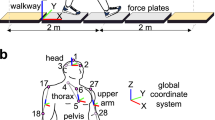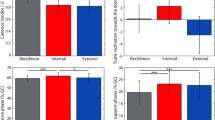Abstract
We studied the coordination of body segments during treadmill walking. Specifically, we used the uncontrolled manifold hypothesis framework to quantify the segmental angular momenta (SAM) synergies that stabilize (i.e., reduce the across trials variability) the whole body angular momentum (WBAM). Seven male subjects were asked to walk over a treadmill at their comfortable walking speed. A 17-segment model, fitted to the subject’s anthropometry, was used to reconstruct their kinematics and to compute the SAM and WBAM in three dimensions. A principal component analysis was used to represent the 17 SAM by the magnitudes of the first five principal components. An index of synergy (ΔV) was used to quantify the co-variations of these principal components with respect to their effect on the WBAM. Positive values of ΔV were observed in the sagittal plane during the swing phase. They reflected the synergies among the SAM that stabilized (i.e., made reproducible from stride to stride) the WBAM. Negative values of ΔV were observed in both frontal and sagittal plane during the double support phase. They were interpreted as “anti-synergies”, i.e., a particular organization of the SAM used to adjust the WBAM. Based on these results, we demonstrated that the WBAM is a variable whose value is regulated by the CNS during walking activities, and that the nature of the WBAM control changed between swing phase and double support phase. These results can be linked with humanoid gait controls presently employed in robotics.








Similar content being viewed by others
References
Asaka T, Wang Y, Fukushima J, Latash ML (2008) Learning effects on muscle modes and multi-mode postural synergies. Exp Brain Res 184:323–338
Asano F, Yamakita M, Furuta K (2000) Virtual passive dynamic walking and energy-based control laws. In: Proceedings of the IEEE/RSJ international conference on intelligent robot design, pp 1149–1154
Bennett BC, Russell SD, Sheth PN, Abel MF (2008) Angular momentum of walking at different speeds. Hum Mov Sci (submitted in Dec 2008, in review)
Black DP, Smith BA, Wu J, Ulrich BD (2007) Uncontrolled manifold analysis of segmental angle variability during walking: preadolescents with and without Down syndrome. Exp Brain Res 183:511–521
Chen Z, Ivavnov PC, Hu K, Stanley HE (2002) Effect of nonstationarities on detrended fluctuation analysis. Phys Rev E Stat Nonlinear Soft Matter Phys 65:041107
Cheng H, Obergefell L, Rizer A (1994) Generator of body data (GEBOD) manual. Air Force Materiel Command, WPAFB, Ohio
Cusumano JP, John J, Dingwell JB (2008) Evidence for goal equivalent control in treadmill walking. In: Proceedings of the NACOB. http://www.x-cdtech.com/nacob/abstracts/550.pdf. Accessed 26 June 2009
Daffertshofer A, Lamoth CJC, Meijer OG, Beek PJ (2004) PCA in studying coordination and variability: a tutorial. Clin Biomech 19:415–428
Danna-dos-Santos A, Slomka K, Latash ML, Zatsiorky VM (2007) Muscle modes and synergies during voluntary body sway. Exp Brain Res 179:533–550
Domkin D, Laczko J, Jaric S, Johansson H, Latash ML (2002) Structure of joint variability in bimanual point tasks. Exp Brain Res 143:11–23
Domkin D, Laczko J, Djupsjöbacka M, Jaric S, Latash ML (2005) Joint angle variability in 3D bimanual pointing: uncontrolled manifold analysis. Exp Brain Res 163:44–57
Duarte M, Sternad D (2008) Complexity of human postural control in young and older adults during prolonged standing. Exp Brain Res 191:265–276
Goodman SR, Latash ML (2006) Feed-forward control of a redundant motor system. Biol Cybern 95:271–280
Goswami A, Kallem V (2005) Rate of change of angular momentum and balance maintenance of biped robots. In: Proceedings of the IEEE international conference on robotics and automation, pp 3785–3790
Herr H, Popovic M (2008) Angular momentum in human walking. J Exp Biol 211:467–481
Hicheur H, Terekhov AV, Berthoz A (2006) Intersegmental coordination during human locomotion: does planar covariation of elevation angles reflect central constraints? J Neurophysiol 96:1406–1419
Hirai K, Hirose M, Haikawa Y, Takenaka T (1998) The development of Honda humanoid robot. In: Proceedings of the IEEE international conference on robotics and automation, pp 1321–1326
Hsue B-J, Miller F, Su F-C (2009) The dynamic balance of the children with cerebral palsy and typical developing during gait. Part I: spatial relationship between COM and COP trajectories. Gait Posture 29:465–470
Ivanenko YP, d’Avella A, Poppele RE, Lacquaniti F (2008) On the origin of planar covariation of elevation angles during human locomotion. J Neurophysiol 99:1890–1898
Jordan K, Challis JH, Cusumano JP, Newell KM (2009) Stability and the time-dependent structure of gait variability in walking and running. Hum Mov Sci 28:113–128
Kadota H, Kudo K, Ohtsuki T (2004) Time series pattern changes related to movement rate in synchronized human tapping. Neurosci Lett 370:97–101
Kajita S, Matsumoto O, Saigo M (2001) Real-time 3D walking pattern generation for a bipedal robot with telescoping legs. In: Proceedings of the IEEE international conference on robotics and automation, pp 2299–2306
Kang N, Shinohara M, Zatsiorsky VM, Latash ML (2004) Learning multi-finger synergies: an uncontrolled manifold analysis. Exp Brain Res 157:336–350
Krishnamoorthy V, Latash ML, Scholz JP, Zatsiorsky VM (2003) Muscle synergies during shifts of the center of pressure by standing persons. Exp Brain Res 152:281–292
Lacquaniti F, Grasso R, Zago M (1999) Motor patterns in walking. News Physiol Sci 14:168–174
Lacquaniti F, Ivanenko YP, Zago M (2002) Kinematic control of walking. Arch Ital Biol 140:263–272
Latash ML (2008) Synergy. Oxford University Press, New York
Latash ML, Scholz JP, Schöner G (2002) Motor control strategies revealed in the structure of motor variability. Exerc Sport Sci Rev 30:26–31
Latash ML, Shim JK, Zatsiorsky VM (2004) Is there a timing synergy during multi-finger production of quick force pulses? Exp Brain Res 159:65–71
Latash ML, Scholz JP, Schöner G (2007) Toward a new theory of motor synergies. Motor Control 11:275–307
Lin D, Seol H, Nussbaum MA, Madigan ML (2008) Reliability of COP-based postural sway measures and age-related differences. Gait Posture 28:337–342
Mitobe K, Capi G, Nasu Y (2004) A new control method for walking robots based on angular momentum. Mechatronics 14:163–174
Olafsdottir HB, Kim SW, Zatsiorsky VM, Latash ML (2008) Anticipatory synergy adjustments in preparation to self-triggered perturbations in elderly individuals. J Appl Biomech 24:175–179
Ono K, Takahashi R (2001) Self-excited walking of a biped mechanism. Int J Robot Res 20:953–966
Peng C-K, Buldyrev SV, Goldberger AL, Havlin S, Sciortino F, Simon M, Stanley HE (1992) Long-range correlations in nucleotide sequences. Nature 356:168–170
Peng C-K, Havlin S, Stanley HE, Goldberger AL (1995) Quantification of scaling exponents and crossover phenomena in non-stationary heartbeat time series. Chaos 5:82–87
Popovic M, Hofmann A, Herr H (2004) Angular momentum regulation during human walking: biomechanics and control. In: Proceedings of the IEEE international conference on robotics and automation. doi:10.1109/ROBOT.2004.1307421
Robert T, Latash ML (2008) Time evolution of the organization of multi-muscle postural responses to sudden changes in the external force applied at the trunk level. Neurosci Lett 438:238–241
Robert T, Zatsiorsky VM, Latash ML (2008) Multi-muscle synergies in an unusual postural task: quick shear force production. Exp Brain Res 187:237–253
Russell S (2008) Ambulation in spastic cerebral palsy: analysis and predictive modeling. Dissertation, University of Virginia
Russell SD, Bennett BC, Sheth PN, Abel MF (2008) The gait of children with and without cerebral palsy: work, energy, and angular momentum. J Appl Biomech (submitted in Sept 2008, in review)
Scholz JP, Schöner G (1999) The uncontrolled manifold analysis concept identifying control variables for a functional task. Exp Brain Res 126:189–306
Scholz JP, Schöner G, Latash ML (2000) Identifying the control structure of multijoint coordination during pistol shooting. Exp Brain Res 135:382–404
Scholz JP, Schöner G, Hsu WL, Jeka JJ, Horak F, Martin V (2007) Motor equivalent control of the center of mass in response to support surface perturbations. Exp Brain Res 180:163–179
Tseng Y, Scholz JP, Schoner G (2002) Goal-equivalent joint coordination in pointing: effect of vision and arm dominance. Motor Control 6:183–207
Wang Y, Asaka T, Zatsiorsky VM, Latash ML (2006) Muscle synergies during voluntary body sway: combining across-trials and within-a-trial analyses. Exp Brain Res 174:679–693
Yang JF, Scholz JP (2005) Learning a throwing task is associated with differential changes in the use of motor abundance. Exp Brain Res 163:137–158
Zeni JA Jr, Richards JG, Higginson JS (2008) Two simple methods for determining gait events during treadmill and overground walking using kinematic data. Gait Posture 27:710–714
Zhang W, Sainburg RL, Zatsiorsky VM, Latash ML (2006) Hand dominance and multi-finger synergies. Neurosci Lett 409:200–204
Author information
Authors and Affiliations
Corresponding author
Rights and permissions
About this article
Cite this article
Robert, T., Bennett, B.C., Russell, S.D. et al. Angular momentum synergies during walking. Exp Brain Res 197, 185–197 (2009). https://doi.org/10.1007/s00221-009-1904-4
Received:
Accepted:
Published:
Issue Date:
DOI: https://doi.org/10.1007/s00221-009-1904-4




